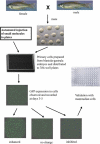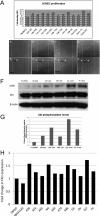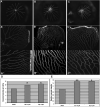High-throughput screening for bioactive molecules using primary cell culture of transgenic zebrafish embryos
- PMID: 22999940
- PMCID: PMC3462279
- DOI: 10.1016/j.celrep.2012.08.015
High-throughput screening for bioactive molecules using primary cell culture of transgenic zebrafish embryos
Abstract
Transgenic zebrafish embryos expressing tissue-specific green fluorescent protein (GFP) can provide an unlimited supply of primary embryonic cells. Agents that promote the differentiation of these cells may be beneficial for therapeutics. We report a high-throughput approach for screening small molecules that regulate cell differentiation using lineage-specific GFP transgenic zebrafish embryonic cells. After validating several known regulators of the differentiation of endothelial and other cell types, we performed a screen for proangiogenic molecules using undifferentiated primary cells from flk1-GFP transgenic zebrafish embryos. Cells were grown in 384-well plates with 12,128 individual small molecules, and GFP expression was analyzed by means of an automated imaging system, which allowed us to screen thousands of compounds weekly. As a result, 23 molecules were confirmed to enhance angiogenesis, and 11 of them were validated to promote the proliferation of mammalian human umbilical vascular endothelial cells and induce Flk1+ cells from murine embryonic stem cells. We demonstrated the general applicability of this strategy by analyzing additional cell lineages using zebrafish expressing GFP in pancreatic, cardiac, and dopaminergic cells.
Copyright © 2012 The Authors. Published by Elsevier Inc. All rights reserved.
Figures






Similar articles
-
The growth of endothelial-like cells in zebrafish embryoid body culture.Exp Cell Res. 2020 Jul 15;392(2):112032. doi: 10.1016/j.yexcr.2020.112032. Epub 2020 Apr 28. Exp Cell Res. 2020. PMID: 32353375
-
Lessons from transgenic zebrafish expressing the green fluorescent protein (GFP) in the myeloid lineage.Methods Cell Biol. 2004;77:333-47. doi: 10.1016/s0091-679x(04)77018-1. Methods Cell Biol. 2004. PMID: 15602920 No abstract available.
-
Establishment of oct4:gfp transgenic zebrafish line for monitoring cellular multipotency by GFP fluorescence.In Vitro Cell Dev Biol Anim. 2015 Jan;51(1):42-9. doi: 10.1007/s11626-014-9805-7. Epub 2014 Dec 17. In Vitro Cell Dev Biol Anim. 2015. PMID: 25515246
-
GFP transgenic animals in biomedical research: a review of potential disadvantages.Physiol Res. 2019 Aug 29;68(4):525-530. doi: 10.33549/physiolres.934227. Epub 2019 Jul 25. Physiol Res. 2019. PMID: 31342754 Review.
-
Genetic tools for multicolor imaging in zebrafish larvae.Methods. 2013 Aug 15;62(3):279-91. doi: 10.1016/j.ymeth.2013.07.028. Epub 2013 Jul 22. Methods. 2013. PMID: 23886907 Review.
Cited by
-
Ecklonia cava Extract and Its Derivative Dieckol Promote Vasodilation by Modulating Calcium Signaling and PI3K/AKT/eNOS Pathway in In Vitro and In Vivo Models.Biomedicines. 2021 Apr 19;9(4):438. doi: 10.3390/biomedicines9040438. Biomedicines. 2021. PMID: 33921856 Free PMC article.
-
Regenerative medicine: Of fish and men.Nat Chem Biol. 2014 Feb;10(2):91-2. doi: 10.1038/nchembio.1449. Nat Chem Biol. 2014. PMID: 24441638 No abstract available.
-
A conserved transcription factor regulatory program promotes tendon fate.Dev Cell. 2024 Dec 2;59(23):3106-3123.e12. doi: 10.1016/j.devcel.2024.08.006. Epub 2024 Aug 30. Dev Cell. 2024. PMID: 39216481
-
Lanthanide Hydroxide Nanoparticles Induce Angiogenesis via ROS-Sensitive Signaling.Small. 2016 Aug;12(32):4404-11. doi: 10.1002/smll.201600291. Epub 2016 Jul 6. Small. 2016. PMID: 27383397 Free PMC article.
-
Oxidative stress inducers potentiate 2,3,7,8-tetrachlorodibenzo-p-dioxin-mediated pre-cardiac edema in larval zebrafish.J Vet Med Sci. 2021 Jul 2;83(7):1050-1058. doi: 10.1292/jvms.21-0081. Epub 2021 May 24. J Vet Med Sci. 2021. PMID: 34024870 Free PMC article.
References
-
- Cao Z, Jensen LD, Rouhi P, Hosaka K, Lanne T, Steffensen JF, Wahlberg E, Cao Y. Hypoxia-induced retinopathy model in adult zebrafish. Nat Protoc. 2010;5:1903–1910. - PubMed
-
- Chen Z, Liu F, Ren Q, Zhao Q, Ren H, Lu S, Zhang L, Han Z. Hemangiopoietin promotes endothelial cell proliferation through PI-3K/Akt pathway. Cell Physiol Biochem. 2008;22:307–314. - PubMed
-
- Cross MJ, Claesson-Welsh L. FGF and VEGF function in angiogenesis: signalling pathways, biological responses and therapeutic inhibition. Trends Pharmacol Sci. 2001;22:201–207. - PubMed
-
- Dimmeler S, Fleming I, Fisslthaler B, Hermann C, Busse R, Zeiher AM. Activation of nitric oxide synthase in endothelial cells by Akt-dependent phosphorylation. Nature. 1999;399:601–605. - PubMed
-
- Djonov V, Schmid M, Tschanz SA, Burri PH. Intussusceptive angiogenesis: its role in embryonic vascular network formation. Circ Res. 2000;86:286–292. - PubMed
Publication types
MeSH terms
Substances
Grants and funding
LinkOut - more resources
Full Text Sources
Other Literature Sources
Molecular Biology Databases
Research Materials

